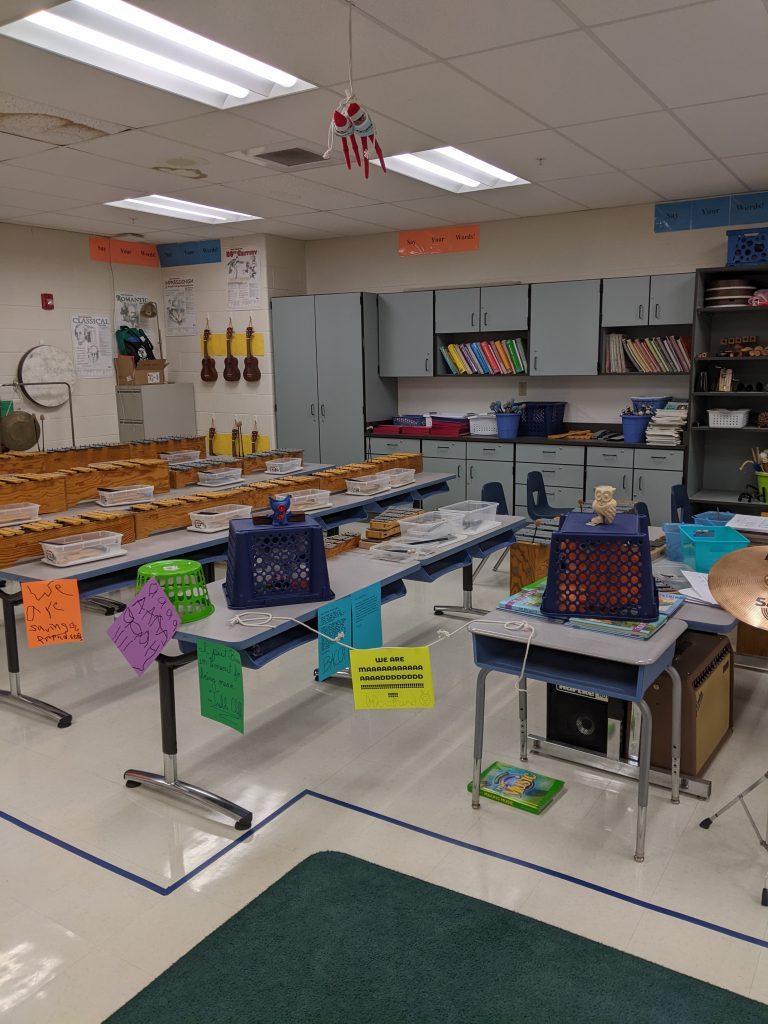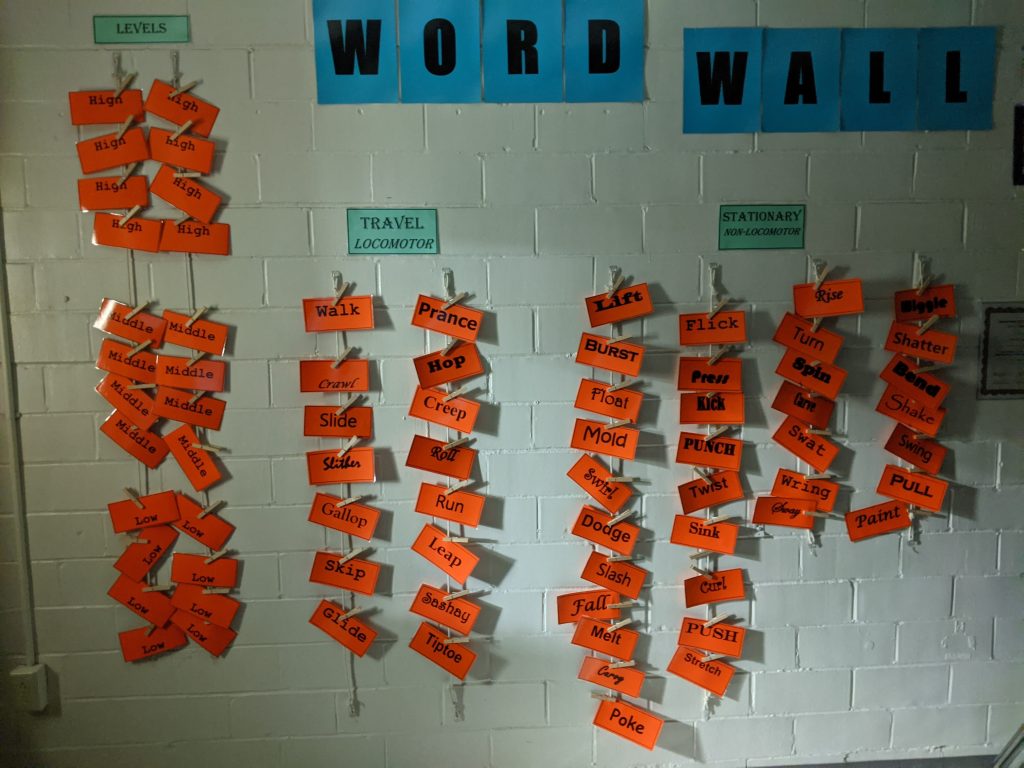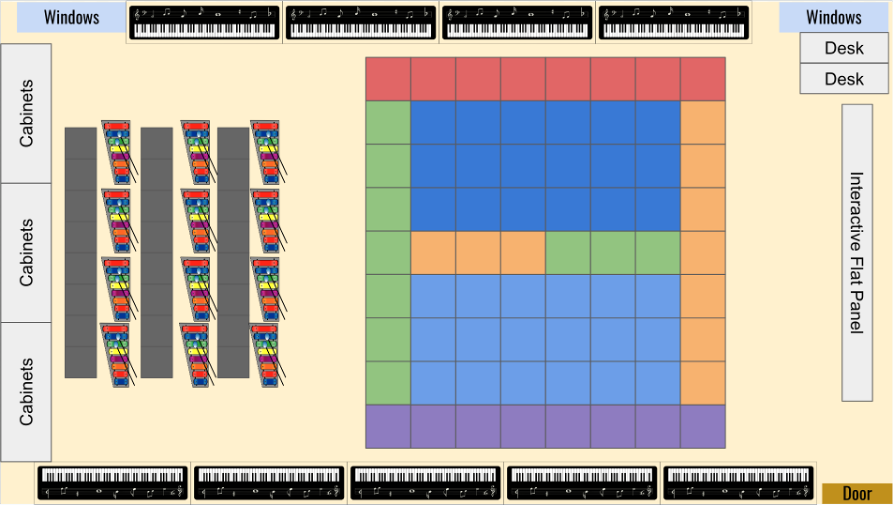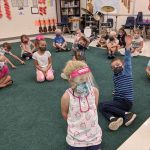2 Setting Up the Classroom and Classroom Management
Martina Vasil; Chris McDowell; Judi Reynolds; and Kailey Holmes
Preparing for the elementary music classroom and school is multi-faceted. This includes thinking about your classroom set up, the procedures you will put in place, classroom management strategies, and how you communicate with stakeholders (the principal, colleagues, staff, and parents).
Classroom Set Up
Identify things that cannot be changed or moved. For example, you may not be able to change the placement of your whiteboard, projector, and the area where your desk is located. The projector will display the computer screen, only if you use certain hookups located in the wall near the desk. This also means that the carpet cannot be moved if you want the students to have a place to sit while watching the whiteboard.
Create as much open space as possible for movement. Movement is necessary when using the Orff process and Dalcroze eurhythmics.
Identify the tools you need the most and make them easy to access. Mr. McDowell’s piano, barred instruments, ukuleles, and unpitched percussion instruments are in constant use in his classroom. He has them always available with easy access. His tubanos, djembes, timpani, and contrabass bars are used sparingly so he has them stored in his storage closet (see picture below).

Be creative with your storage. Mr. McDowell uses command hooks to hang his hand drums on a wall. It saves so much space on his shelves so he can then store many other instruments with easy access. He also hangs his ukuleles with command hooks so they are safe but always available for use.
Create wall displays that are also useful tools. Mr. McDowell’s word wall is a useful tool that he uses in many lessons. This wall of movement words helps the children when they create movement plans.

Gadgets can improve efficiency. Bluetooth speakers and a voice amplifying device will both ensure the recordings you play are loud enough and save your voice over time. Wireless controls for technology are also helpful (i.e., bluetooth keyboard/mouse or a clicker for slide presentations). Gadgets help Ms. Holmes move around while she is teaching, rather than being tethered to her desk. Having a clicker with a laser pointer has helped her a ton with things like sight reading and referencing visual resources on the board.
Think about student seating. Students should have assigned seats. How you determine that is up to you. Ms. Reynolds uses sit-spots and Mr. Mcdowell has a square carpet and students know if they are in row 1, 2, 3, 4 and how many spots in.
Ms. Holmes uses rubber exercise mats in different colors to customize seating. They are cheaper than carpets, are easy to rearrange, and are easier to clean. Her seating space has four colored borders (red, green, purple, and orange). See figure below. She doesn’t have to group students, she can simply say “orange group go to x”. She also shows a slide for seating. She types the students’ names into the squares so they know where to go, and then she has an easy visual available for student teachers and subs.

If you have a small classroom, you might consider organizing your curriculum into units for specific instrument use. In that case, instrument set up could vary, depending on what unit you may be on (e.g., piano unit, Orff unit, ukulele unit).
Classroom Rules and Expectations
Connect to school guidelines. Create consistency by connecting your rules with anything done school-wide. Ms. Holmes’s school follows positive behavior intervention system (PBIS), where teachers focus on desired behaviors as models for all students and never assume students “know better.” If a student is displaying undesirable behaviors, teachers assume they need to be taught. It is the teacher’s responsibility to teach and model the desired behavior. In Ms. Holmes’s school, the rules are:
- Be Respectful
- Be Responsible
- Be Safe
Ms. Holmes and her students talk about what these rules look like specifically for music class. To do so, she uses a social contract. This fosters student agency. Students collaborate with each other and Ms. Holmes to decide what they think the “Be”s should look like in music.
- What does “be safe” look like in the music room?
- What does “be respectful” look like?
- What does “be responsible” look like?
- How do you want the teacher (me) to treat you?
- How does the teacher (I) want to be treated?
- How do we want to be treated by our peers?
- What consequences should be set for breaking the contract? (Ms. Holmes has HEAVY influence on this, but students are welcome to discuss).
Once the discussion is over, Ms. Holmes prints the contract with the agreed-upon responses. Then students sign it and it is displayed in the classroom. This process is completed in grade-appropriate ways K–5 during the first week of school.
Create five or less simple yet broad classroom rules and display them. Let these rules serve as an umbrella for more specific rules that may include how to play instruments, when to play instruments, how to move in open space, etc.
Example: Whole Brain Rules
Start with whole-brain rules and go over them each class period. This can take 60 seconds. This whole-brain approach emphasizes using the body to reinforce statements:
- Rule number 1: Follow directions quickly. (The student uses a hand gesture to demonstrate this.)
- Rule number 2: Raise your hand for permission to speak. (Hand gestures)
- Rule number 3: Raise your hand for permission to leave your seat. (Hand gesture)
- Rule number 4: Make smart choices. (hand gesture)
- Rule number 5: Make our dear team stronger. (Hand gesture)
*Diamond rule: Keep your eyes on the target. (Hand gesture)
I used to think it was nonsense to repeat the rules each class period, especially since we only have 25 minutes. Over time, I learned that if we don’t start with these rules, we end up having to go over them at some point in the class. It is more disruptive in the middle of a lesson and I’ve found that the initial repetition heads off a lot of behavior issues. ~ Judi Reynolds
Always explain your expectations before any activity. This will remind or inform all students of what they should do. Make no assumptions about what your students know. Think about:
- How students will enter and leave your classroom
- How students will find their seats
- How student will ask questions/contribute to discussions
- How students will get instruments or move to instruments
- How students will safely move their bodies through space
- How students will work alone and with others
Example: Moving to Instruments
You want to move your students from their seats on the sit-spots to the keyboards in the back of the classroom. Don’t assume they remember how to move to the instruments from the last class meeting. Whole brain activities quickly reinforce this with movement.
- Say, “We are moving to the keyboards. The expectation is walking feet (walk two fingers on your forearm), put your headphones on (pretend to put headphones on), and find your hand position (pretend to put your hands in the correct spot).
- Say and gesture the expectations as a class and then take five seconds of class for students to practice. Say, “turn to your partner and act this out.”
Elementary music teacher, Judy Reynolds shared:
It is remarkable how this cuts down on the questions like, “did you say headphones…?” They acted it out and reinforced the instructions with a physical activity. It also reduces teacher “sit and get” talk.
Be consistent and follow through. Consistency will allow for your students to know what to expect and will allow them to know how to use your classroom instruments and space. Most general music teachers only see their students once a week. By being consistent from kindergarten through fifth grade, your classroom management will become so much easier.
Follow through is also important. You need a step-by-step system your students are aware will be used for accountability. There (hopefully) should be a school procedure in place for this. Be sure you know your school’s system. Ms. Holmes’s school has tier 1/2/3 infractions and what are appropriate consequences administered by staff or front office staff. All behavior data is tracked through Class Dojo, a digital sharing platform that allows teachers to document the day in class and share that with families via a web browser. Students can earn Dojo Points based on their conduct, letting teachers use the app to foster positive student behavior. This system is viewable by all teachers, administrators and parents.
This is Ms. Holmes’s follow through that follows PBIS:
- The first occurrence receives a private redirection. It is not best practice to call students out in front of their peers. Ms. Holmes takes this opportunity to praise students who are displaying the desired behavior by awarding dojo points.
- If the redirection is unsuccessful, I take a dojo point from the student.
- If losing a point does not impact the student’s choice, a second point is taken and they are removed from the learning activity for a reset. This reset is 5 minutes or less. Ms. Holmes tries her best to conference with the student privately during this time.
- If the behavior persists after rejoining the activity, the student is removed to complete a think-time sheet. This sheet is a guided self-reflection activity (and provides documentation), and a consequence per the infraction list is given. The think-time sheet is scanned and sent home via email/dojo to ensure parents receive the information. The student will not rejoin the class unless Ms. Holmes is confident their behavior will not prevent others from learning.
Be knowledgeable about students with IEPs and 504s for behavior goals. These students have different goals, strategies and are sometimes held to different standards based on their abilities. Be sure you are not disregarding mandated accommodations for behavior. Some of my students use a behavior chart instead of class dojo. Their strategies and data collection is a separate system.
Communicate with parents for positive reasons. Be proactive by building positive relationships with your families. Ms. Holmes brags about her students to their families all the time. This can be a simple note in Dojo or pre-made “caught doing good work!” slip you can fill names in and pass out. Parents are more receptive to addressing poor behaviors when they feel you see the good in their children as well. Do not let the first time you are contacting a parent be for negative reasons.
Teaching Strategies that Help Classroom Management
Praise the students that are doing things right before correcting students that do things wrong. Positive reinforcement usually works to get all students following directions.
In Kentucky, many elementary schools follow the Kagan or Positive Behavioral Interventions and Supports (PBIS). This section reviews both to help you prepare.
Kagan
Kagan is an approach to teaching that engages all students and encourages cooperative learning. It is often used as a part of effective classroom management. Research has shown a multitude of benefits for students when Kagan strategies are used:
- Increased student achievement
- Reduced achievement gap
- Drop in discipline referrals
- Positive social skill development
- Improved race relations
Kagan Structures include:
- Rally Robin: In pairs, students take turns giving verbal responses.
- Timed Pair Share: In pairs, one student talks for a time limit while the other listens. Then partners switch roles.
- Round Robin: In groups, students take turns giving verbal responses.
- Rally Coach: In pairs, one student works on solving a problem while the other coaches. Then they switch roles.
- Stand Up, Hand Up, Pair Up: Students stand up, put their hand up, and quickly find a partner to share or discuss something.
- Quiz, Quiz, Trade: In pairs, students review information with their partner by asking and answering questions. Once they quiz each other, they cheer each other one and move on to another partner. https://www.theteachertoolkit.com/index.php/tool/quiz-quiz-trade
Example: Reviewing Instrument Families using Kagan Strategies
Lesson: Reviewing Instrument Families
Prep: “Quiz, quiz, trade” cards are printed out and one card is given to each student.
Process:
- Students follow the direction, “stand up, hand up, pair up”.
- Teacher sets a timer and students stand up, put their hands up, and have a few seconds to find a partner.
- Students put their hand down when they are toe to toe with a partner. Students who still have hands up find each other. Students decide who is partner 1 and who is partner 2.
- Students use “Quiz, Quiz, Trade:
- Quiz (partner 1 reads their card and partner 2 answers)
- Quiz (partner 2 reads and partner 1 answers)
- Trade (they trade cards)
- When students finish Quiz, Quiz, Trade, they stand back to back with their partner, so the teacher can see when all are finished.
- The process is repeated a few times.
Elementary music teacher, Judi Reynolds, reflected on using Kagan strategies:
The students love Kagan strategies. I take care to keep everything moving quickly with a timer and I move throughout the groups to monitor behavior and accuracy. I use this for note names, reading rhythm patterns, dynamics and instrument families.
I often use Stand up, Hand up, Pair up for solfege and even learning song lyrics. I find this process assures engagement for all students. Moving around the room and changing partners keeps all students accountable. They enjoy it and they really learn the material.
I also use Kagan strategies in my after school choir. They learn the lyrics much quicker when they are accountable to each other. I am careful to keep everything on a timer and monitor the pairs. This process is usually only 10–12 minutes.
Kagan strategies for behavior are excellent. Kagan research defines reasons for acting out and strategies for extinguishing the behavior.
Example: An Attention-Seeking Student
If you have a student who is attention seeking through difficult behaviors, try giving that student a job or a moment to shine at the start of class. Typically students who feel like they are not “getting it” may act out or shut down. Find something they excel in and reinforce that.
I had a student who torpedoed each class in every special across the board. This student was the most attention-seeking child I’ve come across in 23 years. I tried this strategy with him. Each time he came in; I had him stand in front of the class, with my clipboard and check visually who was present. Unbelievably, his antics stopped. ~Judi Reynolds
Positive Behavior Interventions and Supports (PBIS)
Positive Behavioral Interventions and Supports (PBIS) is “an evidence-based, tiered framework for supporting students’ behavioral, academic, social, emotional, and mental health” (PBIS, 2023, para. 1). PBIS relies on an entire school to adopt and use the PBIS system. For PBIS to work in a general music classroom, it must be used by the classroom teachers. Many schools adopt a program to create school-wide behavior expectations. One example is CHAMPS. This system helps to integrate expectations in individual classrooms and in shared spaces like bathrooms.
A PBIS school collects behavior data on positive behavior and negative behavior from students. This data is reviewed by a school committee. This committee uses the data to help guide school-wide policies. Many PBIS schools use Class Dojo (an online behavior application) or something similar to gather behavioral data.
Useful websites:
Other Classroom Management Strategies
Restorative Practices
Restorative practices embrace the idea that when one harm others emotionally or physically, they hold responsibility in repairing those relationships. The focus is on the victim negatively impacted by the action rather than the offender. This is a new focus in Fayette County Public Schools and teachers at Ms. Holmes’s school received training on restorative practices.
Restorative practices affect how teachers talk with students who have harmed others in some way. Teachers use affective statements and questions rather than shallow/accusatory statements. Instead of saying “We don’t talk when a teacher is talking”, someone might say “I feel disrespected when you talk over my directions”. The focus is shifted on the impact of the student’s actions. Instead of asking “What should you have done instead?”, someone might say, “Making rude comments about Susie’s performance hurt her feelings, what should you have done instead? If you are interested in reading more about this, check out The Restorative Practices Handbook by Bob Costello, Joshua Wachtel and Ted Wachtel.
Trauma-Informed Practices
Create a safe classroom culture. Begin each class with daily check-ins (greet at the door), unconditional positive regard, and transparent expectations.
Share power. Let student provide input in repertoire selection and rehearsal notes and allow them to engage in peer learning.
Recognize individual students. Foster mutual, collaborative, and respectful relationships with students. This can be done through identifying and sharing character strengths, using student interest surveys, and creating personalized certificates and awards.
Incorporate self-care techniques. Trauma can manifest in excessive tension. Self-care techniques can help students regulate their muscles and manage their tension. For example, the 4×4 Box Breathing can help. Click here.
De-escalation Techniques (from Ageh Bedell)
- Safety. You have to know the policy to use it. Safety evaluation of classrooms and other school spaces should occur periodically, and changes should be implemented that will enhance everyone’s safety.
- Be proactive and prepared. Expect and plan for violent behavior. Aggression rarely occurs suddenly and unexpectedly, pay attention to the escalation process.
- Increasing tension/anxiety
- Escalating verbal stridency and abuse
- Increasing motor activity (i.e., pacing)
- Defusing Techniques: Physical Space
- Keep a physical distance, two quick steps away or an arm’s distance.
- Approach from the front or side (not behind) and stay face-to-face (don’t turn your back).
- Active eye contact shows you are being attentive, but avoid prolonged or intense eye contact (can be perceived as menacing).

Thinker Stance - Keep your body position small and unthreatening (i.e., hands with palms up at waist level or assuming a “thinker” stance—one forearm crosses the chest, with the opposite elbow resting on it with the index finger on the check or chin. If the student is standing, you should stand. If they are sitting, you should sit. If they are pacing, walk at a slower pace with them.
- Intervention/Communication. Use nonthreatening, nonjudgemental, talk-down strategies to manage affect.
- Avoid arguing.
- Avoid threatening body language (e.g., arms crossed).
- Be honest and precise.
- Respond to affect, not content. Acknowledge and validate their affect, “I can see how angry this made you.” Encourage the student to talk about their feelings. Logic and rational explanation are not helpful at this stage.
- Listen and respond with affirmation and empathy. What do they want that they are not getting?
- Re-establish rapport; students will fear that they will be rejected by you after they have lost control. Reassure students that you just want to help as along as they respect the rules of the classroom. Talk about the need for students to address their frustrations before they get out of hand.
Why does this work? Addressing affect models for students that one can regain control of their emotions by talking about them. It teaches students that they do not have to be violent to feel better. It gives students the opportunity to ventilate their affect, which often diffuses and averts a more violent confrontation.
Communication in Elementary Schools
Understanding how to communicate with your principal, colleagues, staff, and parents is essential when working in any educational institution. In general, communication is the key to building relationships. Good communication skills lay the foundation for trust and understanding.
Principal. The principal is your first person to contact when beginning at a new school. Plan a face-to-face meeting to discuss the current and future music program. Have a list of questions ready as well as your own personal plan for the program. Begin the meeting by asking about your new principal’s expectations. For example, “What would you like to see happen in music classes this coming year? Are there school traditions that I should prepare to continue?” Then discuss your own plans.
After this first meeting, keep your principal updated on progress, changes, performance dates, etc. Invite them to your class and have them participate! I’ll never forget my first year at a new school and the principal came for my observation. I was teaching a third-grade recorder lesson. When she walked in, I handed her a recorder and invited her to join the children. Experiencing the lesson through the children’s eyes really showed her what my teaching was about. So, keep your principal informed and happy with your work. It is almost impossible to have a strong music program without a supportive principal.
Colleagues. You will work with every or almost every teacher in the building. It is extremely important to keep them informed about school or public performances that affect their classrooms. You should have a face-to-face meeting with each grade level involved in school performances. Share your plan for rehearsals and performances and see if they have ideas or needs that should be considered. Make sure they are satisfied with the final plan and share a digital copy with everyone involved. Send email reminders to each teacher several weeks before the performance/practice dates occur. Also, give them spoken reminders as you see them in the hallway or your classroom. The reminders will help to avoid conflict.
Make sure to communicate all plans with your special area team (if you have one, this would include music, art, and P.E., typically) in an email or a shared digital document. Your team will most likely be your biggest support. Build friendships with your team, if possible.
Staff. Actively build a strong working relationship with staff members at your school. This includes office staff, cafeteria workers, and the janitors. Each school has specific procedures for reserving rooms, setting up performance spaces, and tearing down performance spaces. The staff typically know how to best do these things. Treat the staff members well because they will be your best help. Kindly ask them for assistance and they will typically go out of their way to help in your success.
Share information about events with the office staff. They often receive phone calls from parents about these things and this will give the office staff a way to quickly answer any questions.
Parents. As a general music teacher, sharing information about performances and events will be your main form of communication for parents. Avoid writing in paragraphs. Most parents will not take the time to read several sentences. Be concise and to the point. Bullet points are often all that is needed. Share information several months before an event, a month before, two weeks before, a week before, and a few days before. This sounds like overkill but you will have several families that need this reminder.
If you need to contact a parent about their child’s behavior, it is best to call as soon as possible. This allows the parents to hear the story from you first. It also avoids misunderstandings that often occur from emails. If you are uncomfortable making a phone call, ask your behavior coach or principal to help you with the call. Don’t forget to include things that the child does well in the conversation. Parents want to know that you care for their child and you are not just angry with their actions.
Give parents positive phone calls. If you see a child do something amazing, share it with their parents. This helps you to build relationships in your school community. These relationships are, once again, very important to grow your program.
Apps like Class Dojo are lifesavers for music teachers in elementary school. With Class Dojo, teachers have the ability to set up classes for ensembles. Music teacher are also added to each teacher’s classroom. Teachers can post videos from classroom activities and communicate with parents as a class or individually. As a team, all specials teachers (e.g., music, art, and P.E.) can post a monthly newsletter to inform parents/guardians of monthly activities in the Special Area classes. Google classroom provides a great means of communication as well. Both apps translate for parents. Parents have been so happy to see a video of their students’ music class without the worry of confidentially.
References
Clowes, G. (2011). The essential 5: A starting point for Kagan cooperative learning. Kagan Publishing. https://www.kaganonline.com/free_articles/research_and_rationale/330/The-Essential-5-A-Starting-Point-for-Kagan-Cooperative-Learning
Kagan. (2023). https://www.kaganonline.com/index.php
Positive Behavioral Interventions & Supports (PBIS) (2023). What is PBIS? https://www.pbis.org/pbis/what-is-pbis
Van Klompenberg, A., & Beddell, A. (2023, May 21–23). Reconnecting, reframing and restoring: Integrating trauma-informed approaches in music teacher education post COVID-19 [Plenary session]. The Mountain Lake Colloquium for Teachers of General Music Methods, Pembroke, VA.



